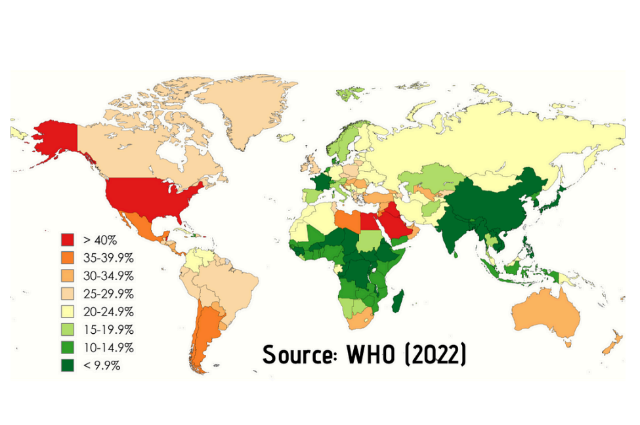
Photo by Towfiqu barbhuiya on Unsplash
Currently, our Prime Minister, along with the most influential people in India, has started a very interesting drive to talk about the side effects of obesity as well as how it can affect the growth of India. It’s a very interesting as well as an important step for the people of India. With a staggering rise in the obesity levels amongst the Indian people, the strength as well as the power to do more work is continuously decreasing. India is following the path of the other developed countries like U.S.A. where people are steadily becoming more obese. This problem is a big crisis not just for India but through out the world as major economies are suffering from this and those developing nations who have not faced this right now will be going to face it soon. “But is this problem really that serious?” That was the question that came to my mind first when I heard about it, but after doing a research on this, all my doubts were cleared, and what I am expecting in this article is to clear your doubts as well.
A WORLD GETTING BIGGER, A FUTURE GETTING SHORTER
So let’s begin by understanding what obesity is first. Obesity is a chronic complex disease defined by excessive fat deposits that can impair health, basically, Obesity is when a person has too much body fat, which can affect their health. It happens when they take in more calories than their body uses over time. Eating a lot of unhealthy food, not being active, and some medical conditions can lead to obesity. It can increase the risk of diseases like diabetes and heart problems. According to a report of WHO(conducted on March,2024),

Share of adults with BMIs > 30 (2022)
- In 2022, 1 in 8 people in the world was living with obesity. 37 million children under the age of 5 were overweight, and 2.5 billion adults (18 years and older) were overweight. Of these, 890 million were living with obesity.
- Worldwide adult obesity has more than doubled since 1990, and adolescent obesity has quadrupled.
People in India think that Obesity is just a normal thing that happens when someone’s wealth grows. For example, a recent conversation with my grandfather revealed a common misconception. When I pointed out his belly fat, instead of acknowledging the issue, he said, “Dear, you don’t understand, a belly is a sign of wealth. If someone is fat, it doesn’t mean they are lazy or unhealthy; it just means they can afford to eat well.” That shook from head to toe. If we follow this logic, billionaires like Vladimir Putin, Bill Gates, or Mark Zuckerberg should be among the poorest, right? Clearly, this belief is misleading and dangerous. The reality is that obesity is a growing threat to humanity. In fact, the World Health Organization (WHO) formally recognized obesity as a global epidemic in 1997. Since 1975, its prevalence has nearly tripled worldwide. People now suffer more from obesity than from malnutrition.
SIZING UP THE CRISIS: HOW OBESITY HAS SPREAD WORLDWIDE
If you think that by doing some exercise and reducing a pound you can be healthy, then it’s a big no because if one remains obese for a long period of time then Cardiovascular Diseases, Diabetes (Type 2) , Joint Problems & Arthritis, Respiratory Issues, Fatty Liver Disease, Certain Cancers & Mental Health Issues will be the some of the issues that will be faced by you soon. We need a guide, and I have some of examples that can rescue us from this epidemic.
DEVELOPED, BUT NOT OVERFED
While many developed nations struggle with obesity, Japan remains an exception. Despite being a major global hub for technology and innovation, Japan has one of the lowest obesity rates, with less than 4% of its adult population classified as obese. But why is this the case? The answer lies in traditional practices such as Hara-hachi-bu (eating until 80% full) and Washoku (a diet focused on fresh vegetables, seafood, whole grains, and moderate protein intake with limited processed foods and added sugars). Unlike Western diets, which are often high in carbohydrates and unhealthy fats, Japanese eating habits emphasize balance and nutrition. This model provides valuable lessons for India as it battles rising obesity rates.
MIND, BODY, SPIRIT
Interestingly, India already has a rich history of health-conscious practices that align with modern fitness trends. Long before science validated these methods, Indian traditions promoted holistic well-being. Yoga, with its asanas and breath control techniques, has been strengthening both mind and body for centuries. Ayurveda prescribes diet plans based on body types, incorporating herbs and spices known for their healing properties. Traditional martial arts, such as Kalaripayattu and Malkhamb, enhance flexibility and endurance, much like today’s functional training. Fasting, deeply rooted in Indian culture, aligns with modern intermittent fasting practices, boosting metabolism and longevity. Spiritual well-being, through mantra chanting and connection with nature, fosters mental peace and balance.
BEYOND GYMS AND DIETS
India doesn’t need to look far for solutions, the blueprint for a healthier life has already been laid out by our ancestors. By embracing a mix of traditional wisdom and modern science, we can combat the obesity crisis effectively. It’s time to move beyond misconceptions and take charge of our health for a stronger, fitter India.
